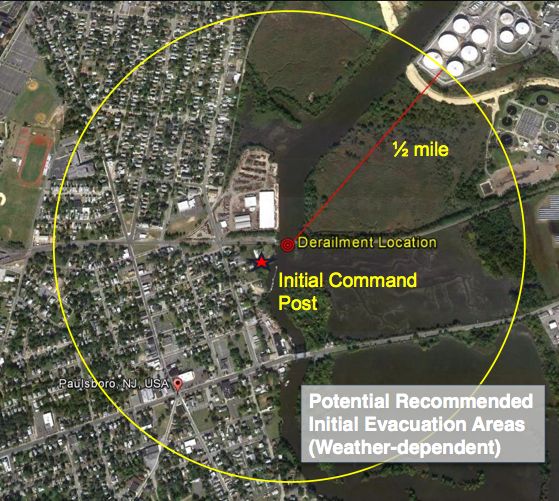National Safety Board Report on Paulsboro Toxic Train Derailment Provides Devastating Criticism Of NJ’s Oversight of Chemical Safety
State Officials Cited by NTSB for Violations of Federal Emergency Response Requirements
DEP Provided False Information to Public That Endangered and Harmed Community
Partial Community Evacuation based of “erroneous reports”
State Failed to correct errors and misinformation when informed about them
“Fact based decisions regarding community exposure did not occur”
NJ, Once a National Leader, Is Now National Laughing Stock
“Shelter in place is what I grew up in as ‘duck and cover.’ The idea that you could somehow shelter in place and be safe from these risks is ludicrous on its face,” Wolfe said. …
These facilities are part of a chemical industrial complex that stretches for about 20 miles along the banks of the Delaware River. Paulsboro is a community that’s pretty much in the middle of that. We were at Paulsboro High School, about a football field away from those facilities.
“The industry has created maps showing where there is called a ‘kill zone’ where in the event of an accident like this, had that been a chlorine tank, literally hundreds or thousands of people could have been killed, instantly,” Wolfe said. ~~~ NJTV News, 12/4/14
Sometimes, it’s no fun to be vindicated and say “I told you so”.
But Tuesday’s National Transportation Safety Board hearing and final report demand both an “I told you so” and an in depth response here. So today, we provide part one – a little of the history and an overview of key NTSB findings.
- Looking Back – A Few Points
I hardly know where to begin and I hate to use such a trite cliche, but you really can’t make this stuff up.
We had been to Paulsboro and written about the place many times prior to the accident (beginning with this 2008 Star Ledger piece “In Harm’s Way) and have been writing about the Paulsboro toxic train derailment since the day it occurred.
From day one, we strongly criticized the emergency response, the limited evacuation, and especially the false and misleading information provided by government officials to the media and the community about the health effects and risks of the chemicals involved .
I went to Paulsboro during the episode and ventured into the “hot zone”.
I knew the accident was far worse than officials told the public and that the emergency response was badly mismanaged, and that’s why we filed a petition seeking performance reviews by the Inspectors General at the EPA and Department of Homeland Security.
I provided the toxic context, explained how state and federal regulations were flawed, transportation infrastructure decrepit, how the reported monitoring data were flawed, how the science and health effects did not support the “shelter in place” response, how monitoring data exceeded federal safety standards, how the risk communication plan was controlled by a questionably competent corporate consultant, and how Gov. Christie failed to respond, not even to the minimum level set by Louisiana Gov. Jindal.
As lawsuits filed by residents prompted the media to probe what went wrong, I thought it was bad when they reported (long after the fact) that the Gloucester County Emergency Response Team lacked batteries for their hand held air monitors.
No biggie, those air monitors just tell emergency responders whether exposure to toxic gases are in concentrations that just might kill them or thousands of nearby residents.
And I knew in real time, and wrote about it extensively, that officials were outright lying about the toxicity of the chemical vinyl chloride, the health risks of exposure, and the faux evacuation and “shelter in place”.
NTSB investigators have now validated virtually all those criticisms – and found far more mistakes, negligence, and potential wrongdoing that I was unaware of.
- NTSB Finds Fatal Flaws
The National Transportation Safety Board hearing and Report on the Paulsboro toxic train derailment has set new lows that even I would not imagine to be possible in a state that was once a national leader and pioneer in chemical safety and risk management. (watch video of hearing here)
The final Report has not been issued yet (updated with links), but there were staff briefings that were revealing and more damning information emerged during the Board’s review of the staff presentations – watch the video for that. For now here is the available written info:
- Chairman’s Introductory remarks (notes that vinyl chlorine is a carcinogen, a fact not initially disclosed)
- Staff power point briefings
- Chairman’s closing statement
- NTSB Synopsis
Here are just some of the egregious errors NTSB found:
- the head of the local response, the Fire Chief, said he couldn’t see or smell the chemical, so no problem
- the emergency response team set up a Command center directly in the “hot zone”, in violation of federal safety guidelines
- none of the emergency responders wore protective breathing apparatus required under federal safety guidelines
- the Paulsboro police told responders and the public that the gas was not toxic. When told of their error, the mistake was not corrected.
- emergency responders were climbing on the derailed chemical rail cars for no reason
- DEP issued public statements about the chemical risks that were flat out false, had no scientific basis, were misleading, and that endangered people. When told of their error, the mistakes were not corrected.
- the partial evacuation lacked a scientific basis and violated federal safety guidelines
- the railroad company, Conrail, intentionally withheld information of the chemicals involved in the derailment
- the Paulsboro local chemical safety and emergency response plan was expired and seriously deficient
- the NJ State Police Office of Emergency Management oversight of local and county programs was a disgrace
I could go on. And will in future posts when the NTSB Final Report is released.
But for now, before we write those more detailed posts, let’s just consider key issues.
First, just look at the map above and focus on the 1/2 mile evacuation radius. That is the minimum evacuation zone recommended by federal emergency response guidelines – it could be far larger for some chemicals like chlorine, which tanker cars carried in this accident.
The emergency responders in Paulsboro failed to meet this minimum evacuation zone radius and there was no scientific basis for the portion of the community that was evacuated.
Second, local officials were not the lead responsible entity for the emergency response and they can not be expected to be experts in chemical safety, so I really can’t blame the local fire chief and local police for egregious falsehoods and mistakes they made.
I blame state and federal officials who are responsible and are supposed to be experts. Those officials made a series of unforgivable “mistakes”, which I will go into in detail once the NTSB Report is released.
The most unforgivable, were the ones NTSB said officials “failed to comply” with federal requirements and “citations for violations” were issued (see slide on page 45)
At the time of the accident, we explicitly said DEP lied to the public – those harsh criticisms have been vindicated.
Adding inset to injury from this scandalous negligence and coverup, I read that the former Mayor of Paulsboro and current State Assemblyman for the city, who served as the head of “communications” for this Keystone Cops fiasco, was “offended” by the NTSB Report.
And we’ll explore Burzichelli’s role as well in future post, leaving for now that he was the former Mayor of Paulsboro, is the current State Assemblyman for the town, and has served as Gov. Christie’s “Red Tape Commission” and sponsored several bills that would roll back environmental protections , allow industry to get involved in developing state drinking water standards, gut NJ’s strict State standards, and weaken the ability of DEP to enforce the law.
Much more to follow on all this.


